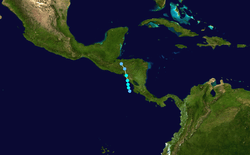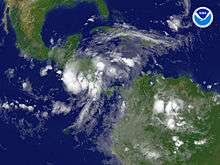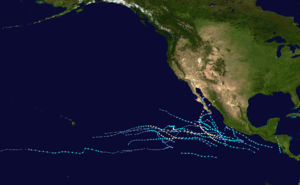Tropical Storm Alma
Tropical Storm Alma of the 2008 Pacific hurricane season was the easternmost forming Pacific tropical cyclone on record. It formed within the monsoon trough just off the coast of Costa Rica on May 29. Initially forecast to remain a weak tropical storm, the cyclone rapidly strengthened and developed an eye before making landfall in Nicaragua near León with peak winds of 65 mph (100 km/h). Alma was the first tropical storm on record to strike the Pacific coast of Nicaragua. In Costa Rica, heavy rainfall caused flooding and landslides, killing two and causing $35 million (USD) in damage. Three people were killed in Nicaragua, one from drowning and two others from electrocution. Five others died in Honduras from an aviation accident likely related to the storm and one other was swept away in floodwaters.
| Tropical storm (SSHWS/NWS) | |
 Tropical Storm Alma approaching Nicaragua on May 29 | |
| Formed | May 29, 2008 |
|---|---|
| Dissipated | June 1, 2008 |
| (Remnant low after May 30) | |
| Highest winds | 1-minute sustained: 65 mph (100 km/h) |
| Lowest pressure | 994 mbar (hPa); 29.35 inHg |
| Fatalities | 4 direct, 7 indirect |
| Damage | $35 million (2008 USD) |
| Areas affected | Central America |
| Part of the 2008 Pacific hurricane season | |
Meteorological history

Towards the end of May 2008, computer hurricane models forecast the development of a broad low pressure area to the southwest of Central America.[1] On May 26, a large trough extended from the southwestern Caribbean Sea across Costa Rica into the eastern Pacific Ocean, forming a broad low pressure area across the region.[2] A scattered area of strong convection developed, partially in association with the Intertropical Convergence Zone.[1] Located within an area of weak steering currents, the disturbance remained nearly stationary, and on May 27 its shower activity increased in organization.[3] Initially the system consisted of several cyclonic swirls, of which the most pronounced one was located about 340 miles (550 km) west-southwest of San José, Costa Rica.[4] The system gradually became better organized, and with a sufficiently well-developed circulation and convective structure, the National Hurricane Center (NHC) classified the system as Tropical Depression One-E at 0300 UTC on May 29, about 105 miles (165 km) west-northwest of Cabo Blanco, Costa Rica.[5]
With a mid-level ridge located in the Gulf of Mexico, the depression drifted generally northward through an area of warm water temperatures and low wind shear. Initially its convection was weak and confined to a few rainbands far from the center. As such, intensification was not expected beyond minimal tropical storm status.[5] However, the system quickly developed intense thunderstorms near the center with increased banding in its southern semicircle, and at 1500 UTC on May 29 the NHC upgraded the depression to Tropical Storm Alma, about 55 miles (85 km) southwest of Managua, Nicaragua. Its intensity was set at 45 mph (75 km/h), and the storm was forecast to intensity only slightly more before moving ashore.[6] However, one hour after it was upgraded to tropical storm status, the NHC re-assessed the intensity as 65 mph (100 km/h), citing updated observations from satellite imagery and QuikSCAT.[7][8] An eye feature formed, surrounded by a very tight ring of convection,[9] and at around 1900 UTC on May 29 Alma made landfall near León, Nicaragua as a strong tropical storm.[10] The storm quickly weakened after moving ashore, though a small area of thunderstorms persisted as it crossed into the mountainous region of southern Honduras.[11] After passing near Tegucigalpa Alma weakened to tropical depression status,[12] and at 1500 UTC on May 30 the cyclone dissipated near the border of Honduras and Guatemala.[13] On May 31, after crossing Central America as a low pressure area, Alma's remnants moved into the Gulf of Honduras and spawned Tropical Storm Arthur.[14]
Preparations and impact
_TRMM_rain_27may-4june08.jpg)
Coinciding with the first advisory on the depression, the government of Costa Rica issued a tropical storm warning for the entire Pacific coast of the country.[15] About four hours prior to landfall, when Alma was named, a tropical storm warning was in effect for the entire coastlines of Costa Rica, Nicaragua, Honduras, and El Salvador.[16] When it was realized the storm was much stronger than previously thought, a hurricane warning was issued for the coasts of Nicaragua and Honduras,[17] and Alma was forecast to attain hurricane status.[7] Prior to moving ashore, the NHC warned that the storm could produce up to 20 inches (500 mm) of rainfall, resulting in mudslides and flash flooding.[16] The National Emergency Commission of Costa Rica activated emergency shelters prior to the arrival of the storm; 250 people in Parrita evacuated from their homes.[18] In Nicaragua, officials evacuated about 5,000 people, while 3,000 troops were mobilized to assist in the aftermath of the storm.[19]
When Tropical Storm Alma made landfall it produced moderate to heavy rainfall across Central America. The city of David, Chiriquí in western Panama reported 5.75 inches (141 mm) of precipitation in 48 hours. Additionally, the capital city of San José, Costa Rica reported 3.07 inches (78 mm) of rainfall in a 48‑hour period.[20] In Costa Rica, the precipitation caused river flooding, threatening 17 communities. It also caused widespread mudslides, which closed at least eight roads. The storm downed trees and power lines, leaving about 42,000 people without electricity in the country.[18] Two deaths were reported in the country, and damage in Costa Rica was estimated at about ₡20 billion colónes ($35 million 2008 USD).[21]
In León near where it moved ashore in Nicaragua, the passage of Alma left the city without power. Several buildings were destroyed in the city, and some roads were damaged. Much of the departments of León and Chinandega experienced power outages, due to the strong winds. One person died from electrocution, due to a downed high-tension cable,[18] and another person died in a similar manner.[22] Offshore, one person drowned when he rode out the storm in his boat.[23] In Tegucigalpa, TACA Flight 390 skidded off a runway sodden by torrential rain, killing three passengers (plus two more on the ground) and injuring over eighty.[8] One other fatality was reported in Honduras when a young girl was swept away in a raging stream.[8]
Records and retirement

Forming at 86.5ºW,[5] Alma developed farther east than any other Pacific tropical cyclone on record. Excluding systems crossing in from the Atlantic, only eight other systems, Francesca in 1970, Bridget and Priscilla in 1971, Jimena in 1979, Paul in 1982, Cristina in 1996, Rosa in 2000, and Selma in 2017, developed east of 90ºW.[24] Alma made landfall farther east than any other Pacific tropical cyclone, and it was the only to do so on the Pacific coast of Nicaragua.[11] When the storm formed on May 29, it marked the ninth year in a row when a Pacific tropical cyclone formed in May, which was the most consecutive years in which storms formed in May.[24] Alma's remnants contributed to the formation of Tropical Storm Arthur in the Atlantic.[14][25]
Despite having a relatively minimal impact on land, the World Meteorological Organization retired the name Alma from the list of Pacific hurricane names and replaced it with Amanda for the 2014 Pacific hurricane season. This makes Alma one of only three tropical storms to have had its name retired in the eastern Pacific; the others were Hazel in 1965 and Knut in 1987.[26][27]
See also
- List of Pacific hurricanes
- Timeline of the 2008 Pacific hurricane season
- List of retired Pacific hurricanes
- Tropical Storm Allison - The first tropical storm to have its name retired in the Atlantic
- Tropical Storm Selma (2017)
- Tropical Storm Amanda (2020)
References
| Wikimedia Commons has media related to Tropical Storm Alma. |
- Nelson (2008). "May 26 Tropical Weather Discussion for the Eastern Pacific Ocean". National Hurricane Center. Retrieved 2008-05-28.
- Berg (2008). "May 26 Tropical Weather Discussion for the Atlantic Ocean". National Hurricane Center. Retrieved 2008-05-28.
- Franklin/Landsea (2008). "May 27 Tropical Weather Outlook". National Hurricane Center. Retrieved 2008-05-28.
- Nelson (2008). "May 27 Tropical Weather Discussion for the Eastern Pacific Ocean". National Hurricane Center. Retrieved 2008-05-28.
- Franklin/Rhome (2008). "Tropical Depression One-E Discussion One". National Hurricane Center. Retrieved 2008-05-28.
- Avila/Roberts (2008). "Tropical Storm Alma Discussion Three". National Hurricane Center. Retrieved 2008-05-29.
- Avila (2008). "Tropical Storm Alma Special Discussion Four". National Hurricane Center. Retrieved 2008-05-29.
- Brown (2008). "Tropical Cyclone Report: Tropical Storm Alma" (PDF). National Hurricane Center. Retrieved 2008-07-22.
- Avila/Roberts (2008). "Tropical Storm Alma Discussion Five". National Hurricane Center. Retrieved 2008-05-29.
- Avila/Roberts (2008). "Tropical Storm Alma Public Advisory Five". National Hurricane Center. Retrieved 2008-05-29.
- Knabb/Blake (2008). "Tropical Storm Alma Discussion Six". National Hurricane Center. Retrieved 2008-05-29.
- Beven (2008). "Tropical Depression Alma Discussion Seven". National Hurricane Center. Retrieved 2008-05-30.
- Avila (2008). "Tropical Depression Alma Discussion Eight". National Hurricane Center. Retrieved 2008-05-30.
- Avila/Rhome (2008). "Tropical Storm Arthur Special Discussion One". National Hurricane Center. Retrieved 2008-05-31.
- Franklin/Rhome (2008). "Tropical Depression One-E Public Advisory One". National Hurricane Center. Retrieved 2008-05-28.
- Avila/Roberts (2008). "Tropical Storm Alma Public Advisory Three". National Hurricane Center. Retrieved 2008-05-29.
- Avila (2008). "Tropical Storm Alma Special Public Advisory Four". National Hurricane Center. Retrieved 2008-05-29.
- El País (2008-05-30). "Alma deja un muerto y cientos de evacuados a su paso por Centroamérica" (in Spanish). Archived from the original on 2011-04-30. Retrieved 2011-04-30.
- Filadelfo Aleman (2008-05-29). "Tormenta tropical Alma golpea Centroamérica" (in Spanish). El Nuevo Herald. Retrieved 2008-05-29.
- Berg (2008). "May 29 Atlantic Tropical Weather Discussion". National Hurricane Center. Retrieved 2008-05-29.
- Werner Stolz & Gabriela Chinchilla. "Tormenta Tropical Alma y sus efectos en Costa Rica (27-30 de mayo de 2008)" (PDF) (in Spanish). Instituto Meteorólogico Nacional. Archived from the original (PDF) on 2011-04-30. Retrieved 2009-03-28.
- Rosenberg, Mica (2008-05-31). "Tropical Storm Alma dies out over Central America". Reuters UK. Retrieved 2008-05-31.
- Agence France-Presse (2008-05-29). "Un muerto y daños por paso de tormenta "Alma"". Archived from the original on 2011-04-30. Retrieved 2008-05-30.
- Hurricane Research Division (2009). "Eastern North Pacific Tracks File 1949-2008". National Hurricane Center. Archived from the original on April 1, 2009. Retrieved 2008-05-28.
- Stephen Caparotta; D. Walston; Steven Yound & Gary Padgett. "Subject: E15) What tropical storms and hurricanes have moved from the Atlantic to the Northeast Pacific or vice versa?". Frequently Asked Questions. Hurricane Research Division, Atlantic Oceanographic and Meteorological Laboratory. Retrieved 2008-05-31.
- World Meteorological Organization (2009-04-22). "Worldwide Tropical Cyclone Names". National Hurricane Center. Retrieved 2009-04-22.
- "RA IV Hurricane Operational Plan" (PDF). World Meteorological Organization. 2008. Retrieved 2009-04-22.
